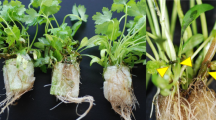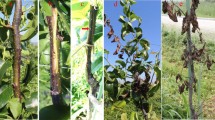Abstract
This study investigated a new fungal disease that attacks Pyropia yezoensis, an economically important red alga that is extensively cultured in China. An incidence was found in a P. yezoensis farm during mid to end November 2012 at Haizhou Bay, Jiangshu Province, China. Histopathology revealed that the naturally infected thalli were overwhelmed by a fungus, leading to progressive red rot symptoms. The causative agent was isolated, grown in pure culture, and identified as a member of the genus Alternaria by morphology and sequence analysis of the nuclear ribosomal DNA containing the internal transcribed spacer (ITS) region of ITS1 and ITS2. In artificial infection experiments on P. yezoensis blades, the fungal isolate was able to cause the same characteristic histopathology seen in natural infections. This fungal isolate grew well at a wide range of temperatures (8–36 °C) and at low salinities (5–50 ‰). In an orthogonal test used to determine the effects of environmental factors (temperature, salinity, and conidia concentration) on disease expansion, it was found that higher temperatures and lower salinities easily caused red rot disease, with the optimal conditions for disease development being 23 °C, 24 ‰ salinity, and a conidia concentration of 105 mL−1. This is the first report to show that Alternaria causes red rot disease in P. yezoensis.





Similar content being viewed by others
References
Arasaki S (1947) Studies on the rot of Porphyra tenera by a Pythium. Bull Jpn Soc Sci Fish 13:74–90
Arasaki S, Inouye A, Kochi Y (1960) The disease of the cultured Porphyra, with special reference to the cancer-disease and the chytrid-disease which occurred at the culture field in Tokyo Bay during 1959–1960. Bull Jpn Soc Sci Fish 26:1074–1079
Berto P, Comménil P, Belingheri L, Dehorter B (1999) Occurrence of a lipase in spores of Alternaria brassicicola with a crucial role in the infection of cauliflower leaves. FEMS Microbiol Lett 180:83–189
Blouin NA, Brodie JA, Grossman AC, Xu P, Brawley SH (2011) Porphyra: a marine crop shaped by stress. Trends Plant Sci 16:29–37
Correa JA (1997) Infectious diseases of marine algae: current knowledge and approaches. Progr Phycol Res 12:139–145
Ding HY, Ma JH (2005) Simultaneous infection by red rot and chytrid diseases in Porphyra yezoensis Ueda. J Appl Phycol 17:51–56
Eshel D, Miyara I, Ailing T, Dinoor A, Prusky D (2002) pH regulates endoglucanase expression and virulence of Alternaria alternate in persimmon fruit. Mol Plant-Microbe Interact 15:774–779
Fan CY, Köller W (1998) Diversity of cutinases from plant pathogenic fungi: differential and sequential expression of cutinolytic esterases by Alternaria brassicicola. FEMS Microbiol Lett 158:33–38
Fujita Y (1990) Diseases of cultivated Porphyra in Japan. In: Akatsuka I (ed) Introduction to applied phycology. SPB, The Hague, The Netherlands, pp 177–190
Fujita Y, Zenitani B (1976) Studies on pathogenic Pythium of laver red rot in Ariake sea farm: I. General mycological characteristic. Nippon Suisan Gakkaishi 42:1183–1188
Gachon CM, Sime-Ngando T, Strittmatter M, Chambouvet A, Kim GH (2010) Algal diseases: spotlight on a black box. Trends Plant Sci 15:633–640
Guan XY, Li J, Zhang Z, Li FC, Yang R, Jiang P, Qin S (2013) Characterizing the microbial culprit of white spot disease of the conchocelis stage of Porphyra yezoensis (Bangiales, Rhodophyta). J Appl Phycol 25:1341–1348
Guiry MD, Guiry GM (2014) AlgaeBase. World-wide electronic publication. National University of Ireland, Galway. http://www.algaebase.org
Kawamura Y, Yamashita Y, Kito H (1991) Growth of Porphyra yezoensis f. narawaensis on culture nets in the nori farm and its environmental conditions. Suisanzoshoku 39:273–278
Kazama FY, Fuller MS (1973) Mineral nutrition of Pythium marium, a marine facultative parasite. Can J Bot 51:693–699
Kerwin JL, Johnson LM, Whisler HC, Tuininga AR (1992) Infection and morphogenesis of Pythium marinum in species of Porphyra and other red algae. Can J Bot 70:1017–1024
Kim MY, Sohn JH, Ahn JS, Oh H (2009) Alternaramide, a cyclic depsipeptide from the marine-derived fungus Alternaria sp SF-5016. J Nat Prod 72:2065–2068
Ma JH (1992) Investigation research of the chytrid disease in Porphyra yezoensis Ueda along south coast of Jiangsu. J Shanghai Fish Univ 5(1):1–7
Ma JH (1996) A preliminary study on the red rot disease of Porphyra yezoensis Ueda. J Shanghai Fish Univ 5(1):1–7
MacArtain P, Gill CI, Brooks M, Campbell R, Rowland IR (2007) Nutritional value of edible seaweeds. Nutr Rev 65:535–543
Mamgain A, Roychowdhury R, Tah J (2013) Alternaria pathogenicity and its strategic controls. Res J Biol 1:1–9
Migita S (1973) Studies on chytrid blight disease of Porphyra. In: Japanese Society of Fisheries Science (ed) The disease of cultivated Porphyra. Koseisha Koseikaku, Tokyo, Japan, pp 12–20
Morrice LM, McLean MW, Long WF, Williamson FB (1983) Porphyran primary structure. Eur J Biochem 133:673–684
Niu C, Kebede H (2008) A safe inexpensive method to isolate high quality plant and fungal DNA in an open laboratory environment. Afr J Biotechnol 7:2818–2822
Noda H (1993) Health benefits and nutritional properties of Nori. J Appl Phycol 5:255–258
Park CS, Kakinuma M, Amano H (2006) Forecasting infections of the red rot disease on Porphyra yezoensis Ueda (Rhodophyta) cultivation farms. J Appl Phycol 18:295–299
Provasoli L (1968) Media and products for the cultivation of marine algae. In: Watarabe A, Hattori A (eds) Cultures and collections of algae. Jpn Soc Plant Physiol, Tokyo, pp 63–75
Rao RS, Kumar CG, Prakasham RS, Hobbs PJ (2008) The Taguchi methodology as a statistical tool for biotechnological applications: a critical appraisal. Biotechnol J 3:510–523
Richards TA, Meredith DMJ, Guy L, David B (2012) Marine fungi: their ecology and molecular diversity. Annu Rev Mar Sci 4:495–522
Sahoo D, Tang XR, Yarish C (2002) Porphyra—the economic seaweed as a new experimental system. Current Sci 83:1313–1316
Saito S, Sasaki M (1973) Studies on red rot disease of Porphyra. In: Japanese Society of Fisheries Science (ed) The disease of cultivated Porphyra. Koseisha Koseikaku, Tokyo, Japan, pp 59–69
Saleem M, Ali MS, Hussain S, Jabbar A, Ashraf M, Lee YS (2007) Marine natural products of fungal origin. Nat Prod Rep 24:1142–1152
Simmons EG (1992) Alternaria taxonomy: current status, viewpoint, challenge. In: Chelkowski J, Visconti A (eds) Alternaria: biology, plant diseases and metabolites. Elsevier, Amsterdam, pp 1–35
Smith JL, Summers G, Wong R (2010) Nutrient and heavy metal content of edible seaweeds in New Zealand. N Z J Crop Hort Sci 38:19–28
Takahashi M (1970) Identification of genus Pythium. Plant Prot 24:339–346
Takahashi M, Ichitani T, Sasaki M (1977) Pythium porphyrae Takahashi et Sasaki, sp. nov. causing red rot of marine algae Porphyra spp. Trans Mycol Soc Jpn 18:279–285
Takashi T, Yoshiaki H, Kazuya A, Kouhei O, Motoichiro K, Yasunori A, Mayumi E, Mikihiro Y, Hiroshi O (2013) Host-selective toxins produced by the plant pathogenic fungus Alternaria alternate. FEMS Microbiol Rev 37:44–66
Tamura K, Peterson D, Peterson N, Stecher G, Nei M, Kumar S (2011) MEGA5: molecular evolutionary genetics analysis using maximum likelihood, evolutionary distance, and maximum parsimony methods. Mol Biol Evol 28:2731–2739
Thomma BPHJ (2003) Alternaria spp.: from general saprophyte to specific parasite. Mol Plant Pathol 4:225–236
Thompson JD, Gibson TJ, Plewniak F, Jeanmougin F, Higgins DG (1997) The CLUSTAL_X windows interface: flexible strategies for multiple sequence alignment aided by quality analysis tools. Nucl Acids Res 25:4876–4882
Tucker SL, Talbot NJ (2001) Surface attachment and pre-penetration stage development by plant pathogenic fungi. Annu Rev Phytopathol 39:385–417
Uppalapat S, Fujita Y (2000) Carbohydrate regulation of attachment, encystment, and appressorium formation by Pythium porphyrae (Oomycota) zoospores on Porphyra yezoensis (Rhodophyta). J Phycol 36:359–366
White TJ, Bruns T, Lee S, Taylor JW (1990) Amplification and direct sequencing of fungal ribosomal RNA genes for phylogenetics. In: Innis MA, Gelfand DH, Sninsky JJ, White TJ (eds) PCR protocols: a guide to methods and applications. Academic, New York, pp 253–288
Yu SH, Cho HS, Kim BR, Park MS (2003) Morphological and molecular characterization of Alternaria isolates from Solanaceous crops. Korean J Mycol 31:103–113
Zhang Y, Mu J, Feng Y, Kang Y, Zhang J (2009) Broad-spectrum antimicrobial epiphytic and endophytic fungi from marine organisms: isolation, bioassay and taxonomy. Mar Drugs 7:97–112
Zheng CJ, Shao CL, Guo ZY, Chen JF, Deng DS (2012) Bioactive hydroanthraquinones and anthraquinone dimers from a soft coral-derived Alternaria sp. fungus. J Nat Prod 75:189–197
Acknowledgments
This project was supported by the National High Technology Research and Development Program (2012AA10A406, 2012AA10A401, and 2012AA10A411), the National Natural Sciences Foundation of China (31372517), and the Special Independent Innovation Foundation of Shandong Province (2013CXC80202).
Author information
Authors and Affiliations
Corresponding author
Rights and permissions
About this article
Cite this article
Mo, Z., Li, S., Kong, F. et al. Characterization of a novel fungal disease that infects the gametophyte of Pyropia yezoensis (Bangiales, Rhodophyta). J Appl Phycol 28, 395–404 (2016). https://doi.org/10.1007/s10811-015-0539-z
Received:
Revised:
Accepted:
Published:
Issue Date:
DOI: https://doi.org/10.1007/s10811-015-0539-z




